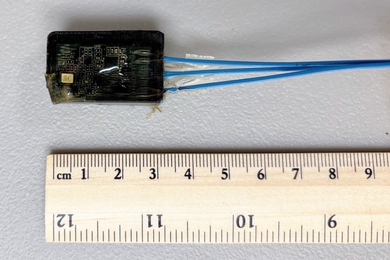Since its founding in 2001, the MIT IDEAS Global Challenge has been a launch point for entrepreneurs and sustainable impact. It has awarded almost $500,000 to more than 90 teams to realize their ideas. In this series, we learn more about the teams that are entering this year.
First responders, including firefighters and police officers, must often take action in potentially lethal situations. Bounce Imaging seeks to decrease the danger for these individuals with a throwable ball that can automatically detect potential dangers in advance. As the ball is bounced into an unseen space, its built-in camera and sensors transmit crucial information to a mobile device.
Bounce Imaging was founded by Francisco Aguilar MBA '12, Aaron Kent '05 and David Young MBA '13. The venture was a 2012 Gold Prize Winner in MassChallenge; it also recently closed a seed capital round and has been featured in national and international media. Most recently, Bounce Imaging was named a 2013 Popular Science Invention Award winner.
This summer, Bounce Imaging will continue to refine their product as they enter field trials with their police partners. They also plan to develop more relationships with first responders around the world. Below, Young talks about the inspiration for Bounce Imaging and its potential applications.
Q. Where did the idea for Bounce Imaging begin? What do you see as the purpose of the device you're creating?
A. We developed the idea for Bounce Imaging after the 2010 Haiti earthquake demonstrated the need for a low-cost, easy-to-use imaging and sensor technology to search for victims after a major disaster. The core concept of "seeing inside dangerous spaces" was then expanded to other first responder applications needed by professionals like police and firefighters. The core purpose of our product is to reduce risk and save the lives of first responders and civilians by allowing personnel to gather information about hazardous spaces and environments before having to enter them.
Q. What types of scenarios do you foresee your technology being useful in?
A. Interviews with police officers suggest that our technology could be applied in hostage situations, active shooter scenarios and other situations where officers feel a threat lies around a corner or in a room. Firefighters in particular hope to use our onboard sensors to detect hazardous gases like hydrogen cyanide and carbon monoxide, which are often present in buildings after fires. They also see the potential in helping to search buildings for victims before they need to decide whether to enter a building. Other first-responder applications range from Homeland Security container inspection to nuclear plant safety, but our initial focus is on the police application.
Q. What have been some of the most memorable moments so far?
A. Our most rewarding moments have been the close interactions we have had with first responders. The chance to spend hours interviewing top SWAT officers or fire chiefs who are excited about our product has been amazing, and we've been blown away by how generous these public servants have been with their time. It has also been an unexpected experience to be highlighted in major publications like TIME and BusinessWeek and on TV, which we never expected. While at times uncomfortable for camera-shy individuals, it has really helped us connect with more first responders.
For more information about Bounce Imaging, visit their website or their IDEAS Global Challenge page. Learn more about how to get involved with the MIT IDEAS Global Challenge on the competition's website.
First responders, including firefighters and police officers, must often take action in potentially lethal situations. Bounce Imaging seeks to decrease the danger for these individuals with a throwable ball that can automatically detect potential dangers in advance. As the ball is bounced into an unseen space, its built-in camera and sensors transmit crucial information to a mobile device.
Bounce Imaging was founded by Francisco Aguilar MBA '12, Aaron Kent '05 and David Young MBA '13. The venture was a 2012 Gold Prize Winner in MassChallenge; it also recently closed a seed capital round and has been featured in national and international media. Most recently, Bounce Imaging was named a 2013 Popular Science Invention Award winner.
This summer, Bounce Imaging will continue to refine their product as they enter field trials with their police partners. They also plan to develop more relationships with first responders around the world. Below, Young talks about the inspiration for Bounce Imaging and its potential applications.
Q. Where did the idea for Bounce Imaging begin? What do you see as the purpose of the device you're creating?
A. We developed the idea for Bounce Imaging after the 2010 Haiti earthquake demonstrated the need for a low-cost, easy-to-use imaging and sensor technology to search for victims after a major disaster. The core concept of "seeing inside dangerous spaces" was then expanded to other first responder applications needed by professionals like police and firefighters. The core purpose of our product is to reduce risk and save the lives of first responders and civilians by allowing personnel to gather information about hazardous spaces and environments before having to enter them.
Q. What types of scenarios do you foresee your technology being useful in?
A. Interviews with police officers suggest that our technology could be applied in hostage situations, active shooter scenarios and other situations where officers feel a threat lies around a corner or in a room. Firefighters in particular hope to use our onboard sensors to detect hazardous gases like hydrogen cyanide and carbon monoxide, which are often present in buildings after fires. They also see the potential in helping to search buildings for victims before they need to decide whether to enter a building. Other first-responder applications range from Homeland Security container inspection to nuclear plant safety, but our initial focus is on the police application.
Q. What have been some of the most memorable moments so far?
A. Our most rewarding moments have been the close interactions we have had with first responders. The chance to spend hours interviewing top SWAT officers or fire chiefs who are excited about our product has been amazing, and we've been blown away by how generous these public servants have been with their time. It has also been an unexpected experience to be highlighted in major publications like TIME and BusinessWeek and on TV, which we never expected. While at times uncomfortable for camera-shy individuals, it has really helped us connect with more first responders.
For more information about Bounce Imaging, visit their website or their IDEAS Global Challenge page. Learn more about how to get involved with the MIT IDEAS Global Challenge on the competition's website.






